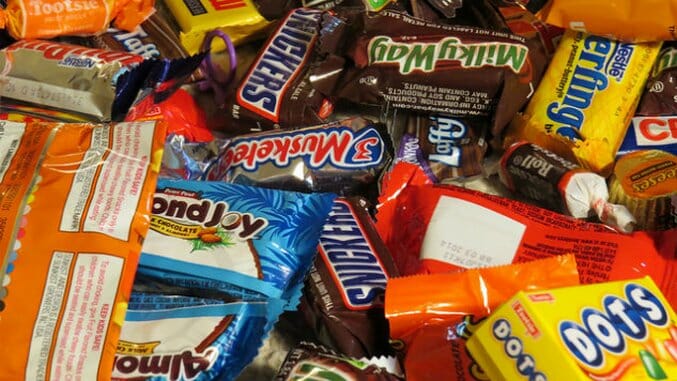Halloween, Candy and the First Holiday After 9/11

The first time I — and many other New Yorkers — went out after 9/11 to do anything deliberately fun was on Halloween. How could we bear to celebrate a holiday about death that year? The city was lighter than usual on grim reapers and grave kitsch in shop windows. There was talk that Halloween should be cancelled, that it was too soon, and that there was nothing funny about ghosts. Would it create more fear to have so many unrecognizable people out on the streets? Would the crowds provide cover for terrorists? Would it be disrespectful to have a good time? Death was serious and not about stuffing your face with candy.
Plastic skeletons and tombstones are Halloween’s decor, but they aren’t the message. If you want to know whether a holiday is really about life or death, ask yourself: does it come with dessert? All the best ones do.
Eating is central to the business of life, and we celebrate the sweetness of that life with dessert. As a pastry chef and the founder of CocoaVino, the first eco-luxury chocolate company making bonbons and confections with fair trade, organic, and locally farm-sourced ingredients, sweets were my life. I relished the sugar-laden aspect of holidays.
There are apples and honey for Rosh Hashanah, milky sweets for Diwali, candy for Halloween, sugar skulls and pan de muerto for Day of the Dead, pumpkin pie (and apple, and pecan) at Thanksgiving, cookies and puddings for Christmas, sticky dates to end the Ramadan fast, King Cake for Mardi Gras, chocolate eggs and yeasted sweet breads for Easter. Even our personal holidays, like birthdays and weddings, come with cake. For thousands of years, sharing sweetness has offered us communion, an intimacy. It has offered us a way to make a day holy.
In the modern era, the state has added new holidays for us to observe. Honoring the dead is their unrelenting theme, but not just any dead will do. Natural disasters don’t cut it. The San Francisco earthquake of 1906 killed 3,000 people (about the same number as 9/11) and reduced a great American city to smoking rubble, but it didn’t get a holiday. Hurricane Katrina didn’t get a day, nor did even deadlier storms in the early part of the 20th century. What does the volatility of nature have to tell us that we want to remember?
War has become our moveable feast, ever adaptable, always telling us who we are. We have Independence Day, Memorial Day, Veteran’s Day, and the most recent Patriot Day. (Remember that one? The bill turning 9/11 into Patriot Day passed the Senate unanimously on November 30, 2001). Government can give us days to observe, but it can’t make them holy.
That’s not to say that to celebrate life, we have to push the dead aside. Everything that lives must die, and there are ways to honor that, and those we have lost, that don’t make us lose our essential grip on life. Some cultures take care of their dead with holidays that look like Thanksgiving, abundant and generous. Across Asia, Buddhists feed their “hungry ghosts.” In Mexico, during the Day of the Dead, people take their ancestors and loved ones a party with their favorite foods, candies, mescal and tequila. They offer a bridge to the dead, to eat and laugh and remember. For a day, they share with them again the sweetness of life.
-

-

-

-

-

-

-

-

-

-

-

-

-

-

-

-

-

-

-

-

-

-

-

-

-

-

-

-

-

-

-

-

-

-

-

-

-

-

-

-








































